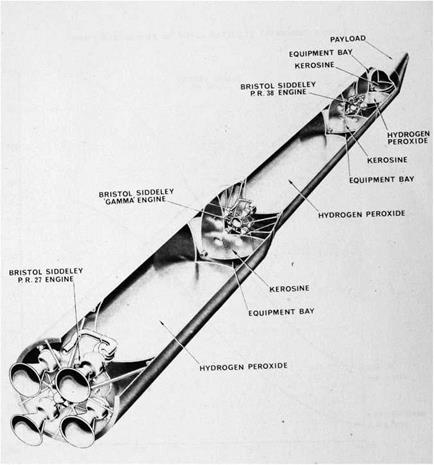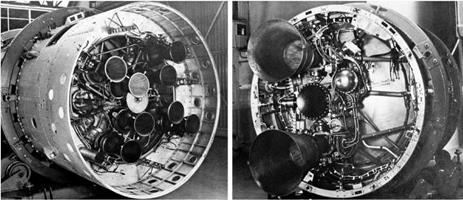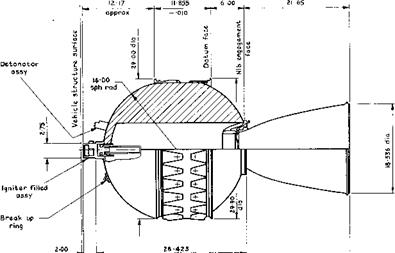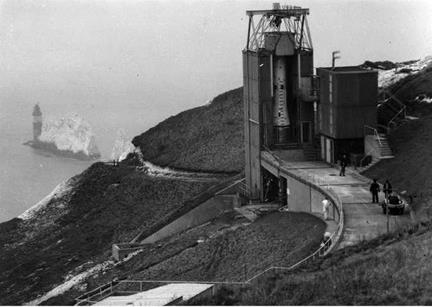Black Arrow
Some of the most interesting moments in the history of a project may never be recorded on paper, since they happen as a result of casual conversation, or, at least, not in meetings with formal minutes. It is not recorded when it was first suggested to develop Black Knight into a satellite launcher, but judging from the various sketches and proposals that began appearing at the end of the 1950s, the idea took root fairly quickly.
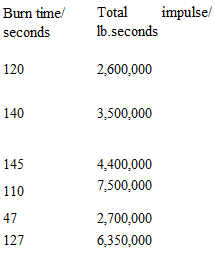 |
|
 |
|
The original Black Knight was not well suited as a satellite launcher. It was simply too small, and could not carry any significant weight in the form of upper stages. Here, for comparison, is some data for Black Knight and various small satellite launchers:
These figures are only approximate, and total impulse is not the only measure of how effective a rocket stage may be, but it gives a good indication. Scout does
 not appear to be that powerful, but it was a four stage vehicle, which improved its efficiency as a launcher. Vanguard was not the first American launch vehicle (although it was intended as such); Diamant A was the first French satellite launcher.
not appear to be that powerful, but it was a four stage vehicle, which improved its efficiency as a launcher. Vanguard was not the first American launch vehicle (although it was intended as such); Diamant A was the first French satellite launcher.
Black Knight had originally been designed with the Gamma 201 motor in mind, which had a thrust of only 16,400 lb, limiting its all-up weight to around
14,0 lb. The Gamma 301 had a greater thrust, which meant that in theory Black Knight could now carry more in the way of upper stages. The Gamma motor could have been further uprated to 25,000 lb thrust, but increasing the thrust without increasing the fuel load means reducing the burn time – the total impulse will stay very much the same. The proposed 54-inch Black Knight is getting closer to Vanguard, although with some way to go.
At around this time, RAE were also becoming seriously interested in liquid hydrogen as a fuel. There was considerable experimental work being carried out at RPE, and also the proposed liquid hydrogen third stage for Blue Streak. Black Knight offered a way of building and testing a liquid hydrogen stage, and producing a satellite launcher at the same time. There are various sketches of such vehicles, but most of the work was summarised in a publication from Space Department of RAE entitled ‘The Orbital Capabilities of Black Knight with a Hydrogen-Fuelled Second Stage’ dated April 19631. Four vehicles are studied, with first stage thrusts of 21,600 lb, 25,000 lb, 40,000 lb and 50,000 lb. Version 1 is 36 inches diameter, all the others are 54 inches. It is not made very clear how the thrusts of 40,000 and 50,000lb are to be achieved. Various combinations of upper stage are modelled – a pump-fed or pressure-fed liquid hydrogen second
stage with a solid fuel third stage. Again, what emerges fairly clearly is the inadequacy of Black Knight as a first stage. The most that could be put into orbit using a pump fed second stage is 88 lb, 102 lb, 324 lb and 377 lb respectively. Given that only versions 1 and 2 relate directly to Black Knight, then this is not very impressive.
The conclusions of the report were that:
This study of the possible use of enlarged versions of Black Knight together with a second stage using liquid oxygen and liquid hydrogen as propellants indicates that such a vehicle can place a payload of about 80 lb into a circular polar orbit at an altitude of 300 nautical miles. Addition of a third stage using a solid propellant increases the payload to about 375 lb.
The advantages of turbo-pump feed for the second stage engine compared to the use of pressurised tanks is quite clear at the stage sizes considered and the payloads just given are for the turbo-pump version. A pressure-fed version would not be capable even of placing the second stage in orbit and in the three stage version, would substantially reduce the payload.
The results of the trajectory calculations for this class of vehicles show that the second stage thrust should be at least twice the total initial mass of the upper stages and payload. This means that the engine developed for this second stage might well have applications for larger upper stages on other vehicles.
There is, of course, another option: using strap-on boosters. This was not considered in the context of the liquid hydrogen stages, but there is no doubt that it would have improved performance very considerably. On the other hand, the idea of Black Knight with added boosters did arise in an entirely different context – RAE was asked by an official at the Ministry of Aviation in October 1961: ‘What has the RAE done on solid propulsion and what has been done on smaller rockets? (Opinion and any possible objections)’
The context is not entirely clear (the document seems to be the transcript of a telephone call), but Dr Schirrmacher gave a fairly lengthy reply, and part of this reads:
For smaller satellites two solutions are worth mentioning:
Black Knight boosted by two Ravens and carrying a Rook as 2nd stage with a Cuckoo as 3rd stage. One will get 100lb into a 200mile orbit. Present development at Westcott for an improvement of the mass fracture [sic – probably fraction] indicates that the payload could probably be increased by a factor 2 [sic].
It is at the moment not clear whether the Black Knight has to be structurally altered. In this case it is estimated that there are altogether two years of development time with Saunders Roe at £650,000 per year and the probable alteration to the gantry. £1.5M would be a likely sum.2
The ‘two solutions’ mentioned is probably a reference to an RAE report written in January 1961 headed ‘Black Knight as a Satellite Launcher’. It takes as its starting point the 36-inch Black Knight ‘Dazzle’ vehicle, with a thrust of 21,600 lb. It mentions that extra fuel could be carried in the main stage (i. e., Black Knight) but without specifying exactly how much. In true RAE style, the report also tends to the theoretical when it uses solid motors ‘similar to’ the Rook, Raven or Cuckoo. It is also not clear why only two Raven strap-on boosters would be used: using four would be almost as easy and would improve the performance considerably (near the end of the Black Arrow programme, RAE did begin investigating an uprated Black Arrow with four such boosters). The conclusion to the report states: ‘It is clear from these results that, unless exotic fuels are used [a reference to liquid hydrogen], the potentialities of Black Knight as a satellite launcher are very limited.’3
The later 54-inch Black Knight is rather a different, and quite a respectable launcher could be made from it using contemporary solid motors. Such a possibility is explored further in Appendix B.
There was another contender for an all-British small satellite launcher, one with a somewhat curious history. In October 1958, David Andrews of Bristol Siddeley Engines (BSE) produced a brochure for an IRBM fuelled by kerosene and HTP, using four of the large Stentor chambers clustered together in a configuration similar to that of the Gamma 3014. Using HTP rather than liquid oxygen as an oxidant in a missile has very clear and definite advantages, as the HTP can be stored in the vehicle for long periods, and there is no problem with ice etc. As a single stage vehicle, its payload over the 2,000 miles range required was small if not minimal. The brochure does not give any breakdown for the weight of the vehicle, but it does give some very detailed drawings of the engine. On the other hand, lightweight warheads were now a possibility after the negotiations with the US concerning atomic weapons, and, failing that, a small solid or HTP stage could have been added. Two stages had been avoided in the design of Blue Streak owing to lack of experience in staging, but by late 1958 this was hardly a novel technique.
The brochure seems to have produced no official reaction at all, even during the Skybolt crisis when it looked as though Britain might be thrown back onto its own resources. On the other hand, dropping the development of Blue Streak for an entirely new design would have been difficult for many reasons: writing off the work done so far would have been difficult politically, and by then Blue Streak had a strong grip on both industry and the Government. In these circumstances a momentum develops: the new design did not have enough to offer to make the change worthwhile.
The vehicle was a good deal smaller than Blue Streak. The design sketch indicates a diameter of 6 ft and a height rather less than 50 ft – effectively an enlarged Black Knight. This would have made the silo smaller and cheaper. The Stentor motor was already under development for Blue Steel: it might have been quicker and cheaper than finishing the development of the RZ 2. Most important of all, using a non-cryogenic fuel would have increased its credibility immensely. The American Titan II missile, which used storable liquid propellants, and was housed in a silo whose design owed something to the Blue Streak silo design, remained in service until the mid-1980s.
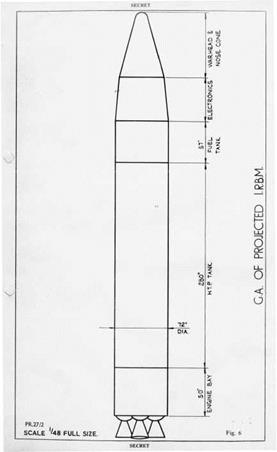 However, it was not to be.
However, it was not to be.
Figure 106. Proposed IRBM design using Andrews did not forget the HTP/kerosene as fuels. idea, however, and later issued
a brochure entitled ‘A Three Stage Satellite Launcher Based on Black Knight and its Technology’5. The brochure is undated, but probably originates from 1962 or 1963. He was an engine designer, and so whilst that part of the brochure is again covered in great detail, there is no General Arrangement drawing, merely an artist’s impression of what the vehicle might look like. A payload of 650 lb to a 300 nautical mile orbit is given, but this is more of an educated guess rather than a figure derived from detailed calculation.
The Bristol Siddeley proposal and the Black Arrow design were costed against each other by RAE with the following breakdown:6
|
Bristol Siddeley Proposal |
Black Arrow |
||
|
First stage: |
|||
|
PR.27/90,000 lb thrust |
£1,770 k |
2 x G303/50,000 lb thrust |
£350 k |
|
Structure & systems |
£5,950 k |
£200 k |
|
|
Second stage: |
|||
|
G303/25,000 lb thrust |
£250 k |
2 x G200/8,000 lb thrust |
£250 k |
|
Structure & systems |
£375 k |
£200 k |
|
|
Third stage: |
|||
|
PR.38/2,000 – 3,000 lb thrust |
£450 k |
Apogee solid |
£150 k |
|
Structure & systems |
£825 k |
£65 k |
|
|
Guidance |
£850 k |
£1,000 k |
|
|
Total so far: |
£10,470 k |
£2,215 k |
Andrews at Bristol Siddeley had said that his design might cost £10 million, but this was almost certainly a guess rather than a detailed estimate. It rather looks as though the breakdown by RAE is designed to arrive at that figure! On the other hand, a figure of nearly £6 million for the structure and systems for the first stage is absurd. It is a cylinder 6 ft in diameter. The first stage of Black Arrow is a cylinder 2 metres (slightly more) in diameter. Why the Bristol Siddeley first stage should cost 30 times as much as the Black Arrow stage is a mystery.
Then some additional items are thrown in – launch sites, range additions and so on – which brought the grand total thus:
Bristol Siddeley: £11,470,000
Black Arrow: £2,915,000
The costing was done at RAE, and Black Arrow was the design produced by Saunders Roe in collaboration with RAE. If BSE were to have seen these figures, they might have had legitimate grounds for complaint!
Plans for enlarging Black Knight had been under consideration for some time. The liquid hydrogen proposals had sketched out vehicles with larger thrust, but without any detailed plans for how this might be done. During 1962, Saunders
|
Figure 107. The three stage HTP/kerosene launcher proposed by BSE. |
Roe turned their attention to a variety of configurations for six and eight chamber motors. The six chamber arrangement was awkward; an eight chamber version was both more logical and more powerful. The next question was how the chambers should be arranged. One possibility was to have four fixed chambers and four swivelling, but control of the vehicle became more difficult. The question was whether the existing arrangement in the Gamma 301 was powerful enough to swivel two chambers rather than one, and tests showed that it was. The motor bay size had not been fixed, and Saunders Roe gave different configurations with diameters of 57.5 inches, 63 inches and 64 inches. In the end, other considerations fixed the size of the bay, as we shall see.
|
Total З I 090 Interstoge 2i3 2 041 Stoge: HTP 5 *oe Kero 7i4 Corcase wt 10 6 0 Total 75 8 2 3rd stoge : Apogee motor 762 Fairings 140 Poylood 213 Total his Nominol vehicle weight 40000 |

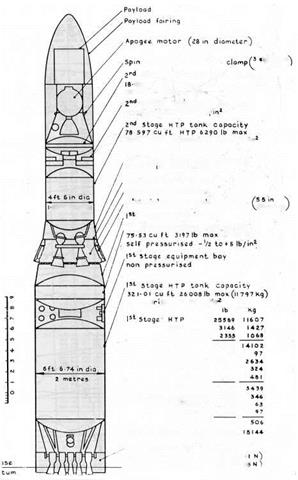
![]()
Arrangement drawing in imperial units – pounds, ft, inches, except one. The diameter of the first stage is 2.0 metres. There is an odd rationale behind this.
Europa 1, the ELDO vehicle, was a combination of Blue Streak plus the French and German upper stages. The French stage, Coralie, had a diameter of
2.0 metres, and so the first stage of Black Arrow was given this diameter as well, so that there was still the possibility of mating Black Arrow to the pre-existing interstage adapter if the opportunity arose – effectively a new version of Black Prince.8 Sadly, the occasion never did arise.
The first stage consisted of engine bay, HTP tank, intertank bay for electronics, kerosene tank and the interstage separation bay. There would be some weight saving if the two tanks shared the same bulkhead, but the decision was taken to separate them to prevent problems if one tank leaked into the other. The HTP tank but not the kerosene tank was pressurised with nitrogen from bottles in the intertank section.
The first stage engine bay had the eight rocket chambers arranged in four pairs of two. Each of the pairs was mounted radially, and were gimballed for vehicle control. Two turbopumps were used to feed the engines. The tanks contained 28,700 lb of propellants, which were consumed in 130 seconds giving a thrust of 50,000 lb at sea level. There was a mixture ratio control keeping the HTP to kerosene ratio to 8.2 : 1.
|
Figure 109. The Gamma 8 motor (left) powered the first stage of Black Arrow, and the Gamma 2 (right) powered the second stage. |
The separation sequence began as the first stage engines ran short of HTP, and soon after the first stage acceleration fell below 3 g, eight explosive bolts were to blow the two stages apart. At the same time four Siskin solid fuel rockets ignited on the second stage – at that point it would be in free fall, and so the propellants would be literally floating in their tanks. The motors provided the force needed to settle the propellants in their tanks (these are sometimes referred to as ‘ullage rockets’). HTP to start the second stage ignition was held in bottles in the interstage section, being forced in under the pressure of nitrogen gas. When the Siskin boosters had burned out, eight more explosive bolts blow off the interstage section.
The second stage used rocket motors which were almost identical to those in the first stage, except that they had extended expansion nozzles for high altitude operation, where there was a much lower external pressure, and there were, of course, only two motors instead of eight. They consumed 6,725 lb of propellant in 125 seconds for a thrust of 15,300 lb. The engines were fully gimballed for control. There was a fuel ratio control system as in the first stage, and, like the first stage, it shut down when the HTP was exhausted. Both tanks were pressurised with nitrogen.
The second stage diameter of 54 inches was a hangover from the 54-inch Black Knight: ‘the second stage, of 54” diameter, is derived from the vehicle being developed for the defence penetration programme’.9
So the second stage had the motor bay, the HTP tank, an intertank bay, the kerosene tank and the separation bay. The electronics were contained in the sealed intertank bay, and included the flight sequence programmer, the attitude reference unit, telemetry, the tracking beacon, the command destruct receivers, the control system servo amplifiers and power supplies.
After the second stage had exhausted its propellants and cut out, it separated, and the third stage plus payload would coast for around 300 seconds towards the apogee of the transfer orbit ellipse. During this time the vehicle would be stabilised by a nitrogen gas attitude control system. Then six solid fuel motors were fired to spin-stabilise the third stage and satellite to around 20 radians per second or about 200 rpm. Five seconds later the third stage and satellite were released.
The vehicle’s third stage was a specially designed solid propellant motor called Waxwing, with 695 lb of propellant, burning for around 55 seconds and producing an average thrust of 3,500 lb. The motor was very efficient, having a ratio of fuel/total mass close to 0.9. The satellite separated from the empty casing of the Waxwing 120 seconds after its ignition by firing gas-generating cartridges. (It turned out that not even this was a sufficient time: it is thought that some residual thrust from the Waxwing caused it to collide with Prospero after it had separated.) This meant three separate objects were put into orbit: the empty motor casing of mass 77 lb, the motor/payload separation bay of mass 31 lb, and the satellite itself.
|
Figure 110. The Waxwing solid fuel motor was the third stage of Black Arrow. |
The Waxwing was sometimes referred to as an apogee motor since it was not ignited until it was near the top of the sub orbital trajectory provided by the first two stages. At this point the third stage and payload would have fallen back to Earth, but the Waxwing gave sufficient extra velocity to put into the payload and itself into a near circular orbit.
The payload shroud or nose cone was made of magnesium alloy. Designed in two parts, it had an overall length of 11 ft 6 inches and a maximum diameter of 54 inches with a mass of 150 lb. Attached to the second stage, it was jettisoned 185 seconds into the flight, during the second stage burn.
When designing small satellite launchers, it is important to get the design right first time. The payload of Black Arrow was only 132 lb from a total lift-off weight of 40,000 lb. If the vehicle has to be redesigned or modified for whatever reason, and ends up not very much heavier (132 lb on the third stage obviously reduces the payload to zero, but there is more latitude on the lower stages), then the payload becomes zero! 132 lb is only 0.33% of the total vehicle weight. Losing 132 lb from a payload of a ton or more has a lot less impact.
|
Figure 111. A Black Arrow vehicle can be seen here in the static test stand at High Down, on the Isle of Wight. The Needles lighthouse can be seen in the background. |
The design having been finalised, the project was put to the Cabinet by Julian Amery, then Minister of Aviation. Again, there was Treasury resistance. A compromise was eventually reached whereby Black Arrow could only go ahead if Crusade and the 54-inch Black Knight were cancelled, with a saving of £4.8 million,10 and Black Arrow was chosen in preference to further re-entry studies.11 In addition, Westland Aerospace, who had taken over Saunders Roe, and Bristol Siddeley, who were to build the new engine, offered to pay a substantial sum, £1 million, towards the development costs. Not surprisingly, Amery greeted this offer with delight. A letter from Westland in February 1965 noted: ‘We expect you to make Management arrangements comparable with the excellent ones you have achieved on the present Black Knight programme. This has been RAE based.’12
However, in retrospect it seems odd that the two projects should conflict: the first stage of Black Arrow would have suited Crusade well. This, however, needs to be seen within the context of British deterrent. By 1964, the UK was committed to the Polaris programme, and Polaris in its original form was considered too small for an extensive system of decoys, and so the later Chevaline system sacrificed one of the three warheads to carry the decoys. When the idea of flight trials for the Chevaline system was considered, Black Arrow was deemed too expensive for the purpose.
The decision to go ahead with Black Arrow was taken in the last days of the Douglas Home Government, and this was to have serious consequences for the project. The incoming Labour Government, not surprisingly, wanted to review many of the major military and technical aerospace projects, and Black Arrow was put on hold. For a Government whose leader won an election with speeches about ‘the white heat of the technological revolution’, the attitude to technology was ambivalent. To put Frank Cousins, a trade union leader with few apparent qualifications for the position, as Minister of Technology was a breath-taking piece of political cynicism on Harold Wilson’s part. To be fair, part of Wilson’s policy was to reduce the number of highly skilled or qualified people working on these projects, so that they could become available for civil work, helping the export drive and so on.
The Treasury got their chance to oppose Black Arrow once again when they prepared a brief for the incoming Chancellor, Jim Callaghan. The brief would have been one of many prepared for him, and this one concerned the space programme and ELDO. (A full version of the brief can be found in Appendix A. It is a very good summary of the Treasury’s position throughout the 1950s and 1960s.) The paragraph on Black Arrow reads as follows:
Apart from some effort within Ministry of Aviation establishments, and a limited amount of research by industry (at government expense) into the basic technology of building satellites, the principal commitment of the UK ‘national civil space programme’ is the development [handwritten: ‘at an estimated cost of £10m.’] of the small satellite launcher based on the military research rocket Black Knight. The decision to go ahead with this development was taken at the beginning of September by the late government. It was justified [handwritten: ‘by the protagonists’] on the grounds that, if Britain is to go in with Europe in collaborative launcher and satellite
development programmes, it was necessary for Britain to have her own ‘research tool’ which would provide her with the necessary technological know-how and an opportunity to test in flight bits of the communications satellites which she will be contributing to the European programme. But no decision has yet been taken on whether the UK should in fact participate in any further European launcher or communications satellite programmes-as stated above, the Treasury would be opposed since to such participation. Until the decisions on this have been taken, it is in the Treasury’s view wholly premature to embark on the development of the United Kingdom small satellite launcher. We recommend therefore that until Ministers have had the opportunity to consider collectively the future course of UK space policy, no work should proceed on a small satellite launcher, and that the project should be regarded as in abeyance. If the Chancellor agrees, we will submit a draft minute for him to send to those of his colleagues who are concerned with these
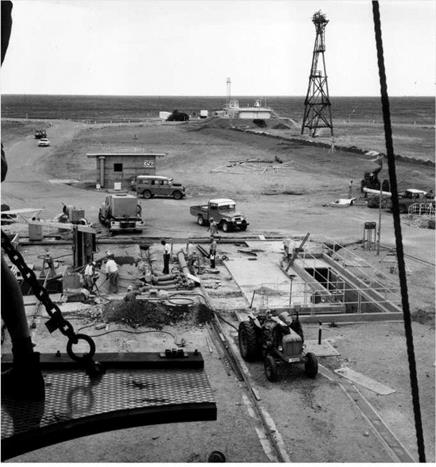 13
13
matters.
Figure 113. One of the two Black Knight gantries was rebuilt for Black Arrow. In the distance is the equipment centre, from where the launches were controlled.
To be fair to the Treasury, there was an economic crisis at the time (when is there not?), and Wilson had made great play with the trade deficit in the election campaign – something which rather backfired on him, as it put sterling under further pressure (those were the days of fixed currency rates, with the pound being worth $2.80).
The firms that were to be involved in Black Arrow, Saunders Roe (who were now part of Westland) and Bristol Siddeley Engines, were given three monthly holding contracts merely to keep the project ticking over. The bigger problem was that as Black Knight wound down, then the teams of engineers and designs involved would disperse unless there was something to keep them usefully employed – which a holding contract did not really do. The offer the two firms had made to contribute towards the development costs faded away as the delays dragged out, and whilst more and more defence work was being cancelled.
Review after review took place14, and each time the project was opposed by the Treasury, which did make some valid points. These points were tied up with general British space policy, which was in a muddle. The new Government wished to withdraw from ELDO but to do so with the least political damage. In particular, they were worried not to give any impression of lack of enthusiasm for joint European projects, and so withdrawal from ELDO at the same time as approving Black Arrow was felt to be giving the wrong signals. On the other hand, if Britain did withdraw from ELDO, Black Arrow could be used to counter arguments that Britain was withdrawing from space research altogether. As usual with such contrary policies, inertia ruled.
There were economic reviews too, to determine whether Black Arrow would be ‘profitable’ or not. It is surprising that no one made the analogy with the likes of the Gloster Whittle aircraft: that was certainly not profitable, yet without it, or other test vehicles like it, there would be no jumbo jets. Was the Wright Brothers’ aircraft ‘profitable’? And the papers are not helped by the jargon used by the economists: one phrase to be found in the papers is ‘exogenous stochastic error’ when talking of the development costs of the vehicle, which in the context appears to refer to unpredicted cost overruns with external origins – in other words, it might end up costing more. The reviews also involved RAE in a good deal of work, having to put forward justifications (usually the same ones) for the vehicle almost every few months.
The arguments for Black Arrow were that it gave British scientists experience in space research at minimal cost, to which the Treasury reply was why did the scientists need such experience? The scope for research satellites was felt by the Treasury to be negligible, Black Arrow was far too small to be of any use in launching communications satellites, and there seemed to be few other uses which would benefit the UK. In many ways the Treasury was right, but the project was fought for by the Ministry of Aviation since it was seen as the last chance for British rocketry: if Black Arrow did not go ahead, the British space effort, or at least rocketry effort, would die.
The Treasury’s attitude to the project was summed up in a letter from FR Barratt in Treasury Chambers to Walter Abson at the Ministry of Aviation in April 1965:
It is claimed that the launcher would be of value in giving UK scientists and technicians experience of injecting satellites into orbit and controlling them, and would also enable us to test satellites and components in an actual space environment. But why should we in fact wish to give UK scientists and technicians this experience? What satellites is the UK going to be putting up? And for what reasons? No decision has yet been taken in regard to a programme of communication satellite and development. Ministers have not yet even been invited to consider the possibility of such a programme. Nor has any military requirement for a UK satellite launching capability been stated. The indications are that no such requirement will arise.
It is suggested that possession of a small satellite launcher will enable us the better ‘to compete for contracts for space projects’. I must remind you that the Working Party… concluded that export prospects in the space field were relatively quite small… It might be as well if you were to specify what contracts we are more likely to get if we have a small satellite launcher. I should myself be very surprised if there was anything significant. If there isn’t, I suggest that you would do better to drop this particular argument.
… I do not myself understand how the development of a small launcher on the basis of ‘proven techniques’ will have much relevance to ELDO activities on, say, high energy upper stages. Doubtless you can explain this. In any event, however, Ministers have yet to reach a final decision on UK policy towards ELDO: it is possible, to say the least, that they will ultimately take the view that we should aim to withdraw from ELDO activities. It is also possible that the attitude taken by the Italians and others at the recent ELDO conference will lead before long to the collapse of the organisation. It cannot therefore be assumed at this stage either that ELDO will continue to exist or that, if it does, the UK will continue to participate in it, or will wish to influence its activities.15
Apart from anything else, this is a marvellous example of the Civil Service at work. The sentence ‘Ministers have not yet even been invited to consider the possibility of such a programme’ tends to suggest how much policy was actually made by the senior civil servants rather than by ministers, and there is also a slight implicit suggestion that options are put up to Ministers to be rubber stamped. And then there is the put down in the third paragraph: ‘Doubtless you can explain this.’
It is also worth noting the attitude to ELDO. But, more importantly, this is a very neat summary of the official attitude to most of these projects. When the Ministry of Technology again tried to get Cabinet approval in 1966, the then Chancellor of the Exchequer, Jim Callaghan, wrote a three page letter of protest reminiscent of those written by Selwyn Lloyd on Blue Streak. Again, the project had to be referred back for further economic studies before it was resubmitted to Cabinet. And the idea of economic reviews, cost benefit analysis, and the like was a new phenomenon. In the 1950s, projects were given a go-ahead mainly on their technical merit. Now the economists were creeping in. This is not intended to be an entirely pejorative comment. The costings of a good number of earlier projects had been completely unrealistic, and a sharper eye on estimates would be welcome. But that is not what the economists were looking at. How do you try to estimate an economic return from basic research? But it was probably the earlier gross under-estimates of earlier projects that made the Treasury so sceptical.
In addition, there were even those in the Space Department at Farnborough who felt that a satellite launcher took up too much of the space budget, to the detriment of other projects. Others in the Ministry of Defence felt that the offer of free launches from the Americans should be used instead, or, even if they did have to pay for them, then it was still cheaper than developing a British launcher. Needless to say, once Britain’s last vehicle was cancelled, the offer of free launches evaporated with it.
There were further financial problems: the Ministry of Defence wanted nothing to do with the funding of the programme. This meant that there might have been potential problems with the use of Woomera, as Black Arrow was, strictly speaking, a civilian programme, and so did not fall under the Joint Agreement between Britain and Australia. And indeed at this time the future of Woomera was being reconsidered – ELDO was moving to South America and thus there would be no more Blue Streak launches, and the number of new missiles under test was shrinking fast. Thoughts turned to alternative Black Arrow launch sites. Barbados was high on the list, but the RAE also looked at launch sites in the UK
Britain is not well situated geographically for satellite launching (but neither was Woomera). Payloads can be boosted by firing the rocket in the same direction of the spin of the Earth: eastwards. But this would mean that the spent rocket stages would fall on Europe, and, not surprisingly, people in Europe might object to this. The only clear path would involve launches almost due north, into polar orbit, and for this, two sites were considered. One was the existing rocket test site on the islands of North and South Uist in the Hebrides; the other was on
the north coast of Norfolk in the region of Brancaster. South Uist was ruled out on grounds both of accessibility and of infrastructure – indeed, it was considered by the Ministry of Aviation to be less accessible than Woomera. Certainly the weather in the Outer Hebrides would have posed a problem. The planned flight paths are shown in Figure 114. The first stage impact points are shown, and the second stage would impact close to the North Pole, north of the 85° parallel.
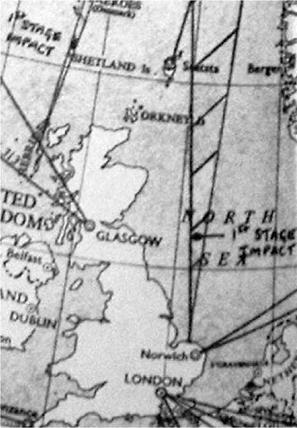 A team went from RAE to look at the area, and concluded:
A team went from RAE to look at the area, and concluded:
No particular site has been
chosen at this time. There Figure 114. The flight path of Black Arrow launched are several areas north of from Norfolk the coastal road which
appear adequate. Ideally a suitable site would be within about five miles of a disused airfield or W. D.-owned site with existing roads and buildings. All that would be required in these circumstances would be the construction of a launch site on the coast line and all the other operations could be conducted at the other site, the two being linked together by microwave and hard wire links.16
A further memo in October 1966 noted that:
For Black Arrow, a site in East Anglia for polar launching has been studied in considerable detail by Space Department, RAE, and found to be technically very attractive. Their itemised estimate for equipment gives a figure of around £1M, to which must be added the complementary civil engineering costs to cover installation and general services. These latter costs are very dependent on the site chosen and at a first broad estimate might amount to as much as £2M, making a grand total of perhaps £3M; a considerable reduction should be available if a suitable disused camp
or airfield became available. Such a site would supersede Highdown for vehicle check-out and static firing purposes, and would have the simplest (and cheapest) supply and maintenance problems.
Polar launching of Black Arrow from N. Uist appears quite feasible, but such a site would not supersede Highdown, and would have substantial technical and logistical disadvantages compared with East Anglia; clearly the remoteness of the area would increase considerably installation, operation and maintenance costs.
The Norfolk launch site looked quite promising until someone realised that the North Sea was beginning to fill up with oil rigs. A chart was rapidly fetched from the Ministry of Power:
…discussions have been held with the Ministry of Power, and a chart obtained showing the position of existing and proposed oil rigs. Although it would be possible to show statistically that the chances of hitting an oil rig would be acceptably low, it seems probable that political considerations would inhibit the establishment of a launch site in Norfolk.
The chances of a spent first stage falling on an oil rig were minute, but given the consequences if one did, the proposal was dropped. The other launch sites being considered were outside the UK (although it is slightly surprising that the Lossiemouth/Inverness area was not considered) and were too expensive to set up. It was back to Woomera.











